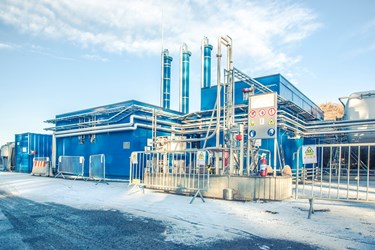Biogas Liquefaction Plant Supplied By Wartsila To Produce Biofuel For Buses In Norway

By being able to convert household food waste into liquid biogas, this new liquefaction plant is able to produce enough fuel to run 135 buses. As a result, carbon dioxide (CO2) emissions will be reduced by some 10,000 tons a year. Particle emissions will also be significantly lowered and noise levels will be reduced.
The biogas liquefaction plant delivered by Wartsila to the Norwegian Cambi AS, a specialist in biowaste treatment, is inaugurated on 12 February 2014. The plant, operated by Cambi AS on behalf of EGE (Waste-to-Energy Agency) and the City of Oslo, will produce biomethane from household food waste to be used as biofuel for buses in Oslo, thereby putting the region at the forefront of environmental innovation. EGE produces environmentally friendly energy from waste and is underthe supervision of the City of Oslo's Department of Environmental Affairs and Transport.
The plant is located in Nes, Romerike, an agricultural region close to Oslo. When fully operable it will treat 50,000 tons of food waste a year to produce around 14,000 Nm3 (normal cubic meters) per day of biomethane. The liquefied biogas (LBG) can be efficiently transported for use as fuel.
Wartsila is a leading developer and supplier of gas handling and liquefactiontechnology. The Wartsila liquefaction technology is based on more than 50 years of experience in the marine and oil & gas markets. The new facility's liquefaction plant design uses conventional components in a mixed refrigeration process. The technology is scalable upwards to a capacity of at least 60 tons per day.
"This plant will mean that 135 Oslo region buses will be able to run on biogas. As a result, CO2 emissions will be reduced by some 10,000 tons a year and particle emissions will also be significantly lowered. The air will be cleanerand noise levels will be reduced, and these are benefits that everyone in the region will enjoy," noted Jannicke Gerner Bjerkas, Director Communications and CSR, Waste-to-Energy Agency, City of Oslo.
"We are proud and delighted to be involved in this groundbreaking project to produce a new, renewable, and environmentally sustainable transportation fuel. There is huge potential for the use of LBG from renewable energy sources as fuel for trucks and buses, and this project is an important step forward in developing this market. This same technology can also be used in small liquefaction projects with other sources of gas as well, and we are excited about the future possibilities," says Tore Lunde, Managing Director, Wartsila Oil & Gas Systems.
The EU has set a target to have a 20 per cent share of energy produced from renewable sources by the year 2020.
About Wartsila
Wärtsilä is a global leader in complete lifecycle power solutions for the marine and energy markets. By emphasising technological innovation and totalefficiency, Wartsila maximises the environmental and economic performance of the vessels and power plants of its customers.
In 2013, Wartsila's net sales totalled EUR 4.7 billion with approximately18,700 employees. The company has operations in more than 200 locations in nearly 70 countries around the world. Wartsila is listed on the Helsinki, Finland. For more information, visit www.wartsila.com
Source: Wartsila Corporation
